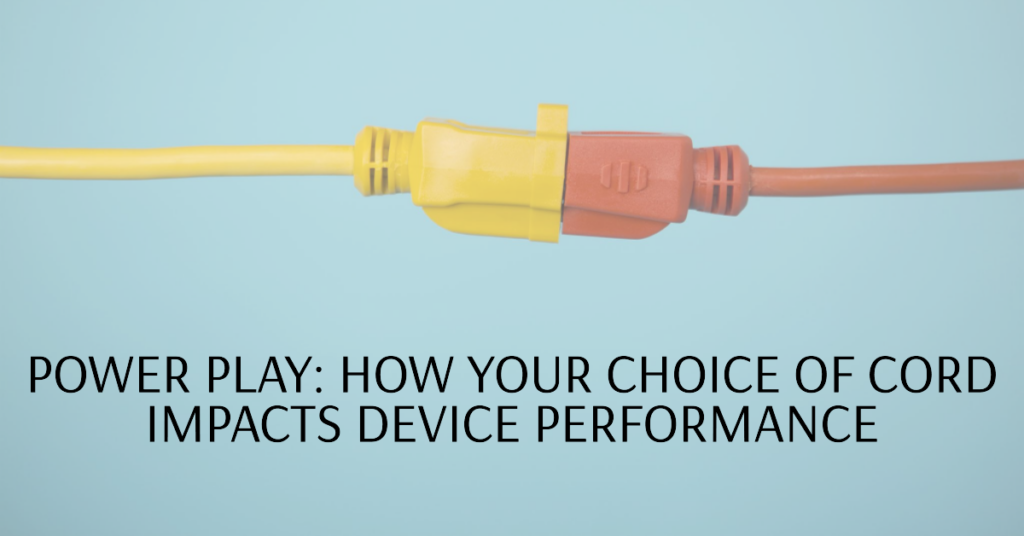

Power Play: How Your Choice Of Cord Impacts Device Performance

Power cords rarely get the shout-out they deserve. These power cable types are found almost everywhere, from offices and homes to construction sites and industrial settings. They streamline data transfer, device charging, and powering electronics. Many power cords have power ratings and come in many shapes, sizes, and types to match every power and data transfer need. High-quality cords rated for the devices you want to charge, or power can improve overall efficiency.
Ways Your Cord Choice Impacts Device Performance

The relationship between cords and electrical devices is that one is a transit unit while the other is a recipient. A power cord is a line through which electrical energy from a source transit into the device. Aluminum and copper are the most prevalent cord materials because of their higher electricity-conduction ratings.
Power cords create a pathway for electrical current to flow from a power outlet to the device. The following are different ways power cords impact the performance of your electrical device.
1. Electrical Resistance Affects Power Flow

Every switch power cord has a specified electrical resistance rating. When electrical current transits through the cables, it undergoes resistance. Even high-voltage power cables may cause voltage drops owing to electrical resistance.
Longer cords record higher voltage drop. That adversely impacts the performance of devices with a higher sensitivity to voltage changes. The resistance recorded on power cables causes power loss. Power loss decreases the performance of power-hungry devices and can cause overheating.
Electrical resistance triggers data errors in data cables. Vibration and temperature changes affect cord resistance. That leads to the distortion of the signals transmitted through the said cable. Devices transmitting data, like network routers and computers, record data error issues.
2. Power Strips Protect Devices from Overload and Surges

Power strips and other power supply cable types have features that prevent devices from power surges and overloads. The grounding conductor in top-quality power strips safeguards your device from power surges and damage. Remember, poor grounding in electrical cords can lead to electrical shock and even data loss.
Many power cables have circuit protection features such as fuses and circuit breakers. The purpose of such power cord features is to disconnect your devices from power when power surges. When your devices draw more than enough electrical energy from the source, the fuse blows, and the circuit breaker trips. That ultimately cuts the power supply and prevents damage to the power strip and connected devices.
3. Power Cables Enhance Portability
The one goal of a power chord inventor is to transport electrical energy safely from the source to the device. The rise of outdoor recreational activities needing power use increased the need to invent power cords. As many people got into camping, outdoor festivals, and hiking, the need to keep devices efficiently powered arose.
Similarly, the need for power has grown in construction sites, necessitating temporary power source usage. These cords bring the power to the user, no matter the distance from the main outlet.
Sourcing power from the grid and transporting it around the house or business premises requires a power cable with a matching rating. When the power transported to your devices is more than necessary, your devices will not work.
Higher electrical amperage can damage devices and even cause fires. Consider checking the power rating of the devices you buy. You never want instances when you have to deal with excess or insufficient power issues because of the wrong power cord.
4. Power Cord Integrity Affects Performance

The performance of your devices depends on the integrity of the 10 foot power cord you choose. Power cables with integrity issues cannot efficiently transmit the electrical signal to the device. Damaged cords cause intermittent connections, power distortion, and poor signal.
It mainly happens when the power connector loosens or if the cord breaks. When connecting to a c15 power cable with integrity issues, your device will lose power abruptly. You may notice a trend where the device powers on and off unexpectedly.
Get high-integrity electrical power cords to power devices without distortion issues. Use high integrity computer power cords to avoid noise and loss of data. You would never want to deal with a computer that restarts itself because of the inconvenience and time wastage. Connect your lighting fixtures to high-quality cords with no integrity issues to avoid flickering. All data cables must be in perfect condition to prevent data loss.
Wrapping Up
The last thing you want is to have problems running your devices because of power cord integrity issues. A damaged power cord affects the amount of energy delivered to your device. That affects the performance and reliability of your device.
Buy high-quality power cords rated as top integrity solutions for the device you want to power. They ensure a quality power supply to your devices and minimize distortions, power loss, and noise. It also prevents issues with unexpected restarting. Have your power cords inspected regularly for signs of damage. This way, you can keep your devices functioning optimally and minimize safety hazards.
